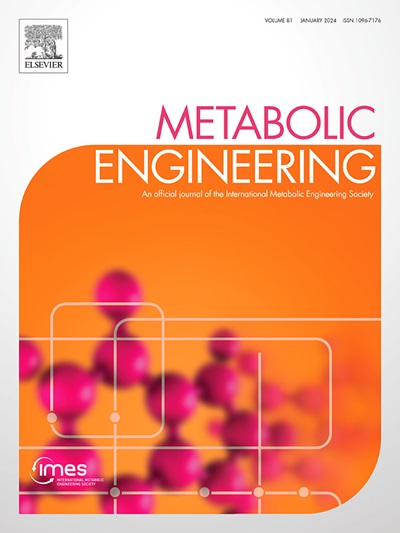用于中枢代谢动态控制的工程遗传电路
IF 6.8
1区 生物学
Q1 BIOTECHNOLOGY & APPLIED MICROBIOLOGY
引用次数: 0
摘要
遗传调控工具已经被研究,因为它们能够对微生物细胞工厂的生物合成进行复杂的动态控制,提高有价值化合物的生产性能。然而,大多数遗传工具是途径特异性或中间特异性的,阻碍了它们在合成生物学中的广泛应用。此外,它们在细胞生长和产物形成之间的中心代谢中平衡代谢通量的潜力仍未得到充分探索,这就提出了它们是否能促进有效的生物合成的问题。为此,我们建立了响应丙酮酸的PdhR生物传感器系统,动态调节中枢代谢的代谢通量分布。在这项研究中,我们首先通过筛选来自不同微生物的多个PdhR同源物来表征PdhR生物传感器系统的剂量效应。计算分析进一步指导识别导致其功能差异的关键因素,从而通过位点定向诱变优化生物传感器性能。作为概念验证,我们利用我们的生物传感器系统分别改善海藻糖和4-羟基香豆素(4HC)的生物合成。其中海藻糖滴度提高到3.72 g/L,是对照组的2.33倍。此外,我们将4HC滴度提高到491.5 mg/L,比静态策略提高了1.63倍。综上所述,建立的中枢代谢响应生物传感器系统强调了代谢通量分布的必要性,并验证了其在中枢代谢衍生化合物的生物合成中的广泛适用性。本文章由计算机程序翻译,如有差异,请以英文原文为准。
Engineering genetic circuits for dynamic control of central metabolism
Genetic regulation tools have been examined for their ability to enable sophisticated dynamic control of biosynthesis in microbial cell factories, enhancing the production performance of valuable compounds. However, most genetic tools are pathway- or intermediate-specific, hindering their broad applicability in synthetic biology. Moreover, their potential to balance metabolic fluxes in central metabolism between cell growth and product formation remains under-explored, raising the question of whether they can facilitate efficient biosynthesis. To answer this, we established the PdhR biosensor system that responds to pyruvate to dynamically regulate metabolic flux distribution in central metabolism. In this study, we first characterized the dose response of PdhR biosensor system by screening multiple PdhR homologs derived from various microorganisms. Computational analysis further guided the identification of key factors contributing to their functional differences, enabling the optimization of biosensor properties through site-directed mutagenesis. As proof of concept, we employed our biosensor system to improve the biosynthesis of trehalose and 4-hydroxycoumarin (4HC), respectively. Specifically, trehalose titer increased to 3.72 g/L, which is 2.33-fold higher than the control group. In addition, we improved the 4HC titer to 491.5 mg/L, which possessed a 1.63-fold increase over the static strategy. In summary, the established central metabolism-responsive biosensor system underlined the necessity of metabolic flux distribution and validated its broad applicability in the biosynthesis of central metabolism-derived compounds.
求助全文
通过发布文献求助,成功后即可免费获取论文全文。
去求助
来源期刊

Metabolic engineering
工程技术-生物工程与应用微生物
CiteScore
15.60
自引率
6.00%
发文量
140
审稿时长
44 days
期刊介绍:
Metabolic Engineering (MBE) is a journal that focuses on publishing original research papers on the directed modulation of metabolic pathways for metabolite overproduction or the enhancement of cellular properties. It welcomes papers that describe the engineering of native pathways and the synthesis of heterologous pathways to convert microorganisms into microbial cell factories. The journal covers experimental, computational, and modeling approaches for understanding metabolic pathways and manipulating them through genetic, media, or environmental means. Effective exploration of metabolic pathways necessitates the use of molecular biology and biochemistry methods, as well as engineering techniques for modeling and data analysis. MBE serves as a platform for interdisciplinary research in fields such as biochemistry, molecular biology, applied microbiology, cellular physiology, cellular nutrition in health and disease, and biochemical engineering. The journal publishes various types of papers, including original research papers and review papers. It is indexed and abstracted in databases such as Scopus, Embase, EMBiology, Current Contents - Life Sciences and Clinical Medicine, Science Citation Index, PubMed/Medline, CAS and Biotechnology Citation Index.
 求助内容:
求助内容: 应助结果提醒方式:
应助结果提醒方式:


